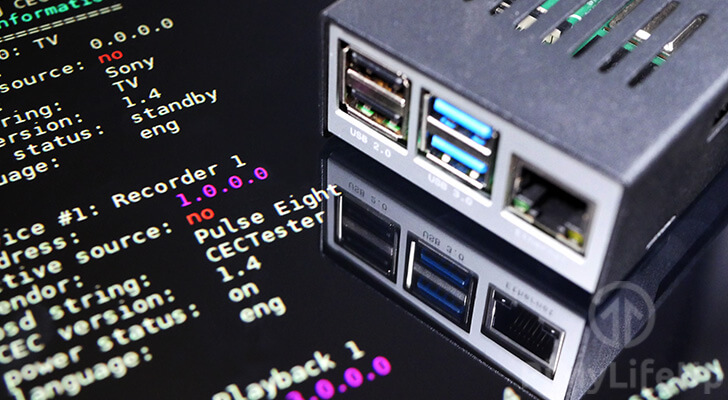在本教程中,我将展示如何使用HDMI-CEC和树莓派来控制电视。
HDMI-CEC是一种特殊的协议,用于电视与另一个设备通过HDMI电缆进行通信。该协议允许电视控制另一个设备,同时也允许该设备控制电视。
大多数现代电视实现了对这一协议的支持,但通常需要在电视的设置中启用。搜索电视型号应该可以找到这个设置的名称。
使用HDMI-CEC协议,可以使用树莓Pi以各种姿势控制电视,如关闭和打开或改变音量。
设备清单
以下是所有的设备清单,点击链接可以直达特别优惠购买。
建议
- ? 树莓派
- ? 高速SD卡
- ? 树莓派4B电源
- ? 以太网线或WiFi (Pi 3内置WiFi)
- ? HDMI
可选
在这个使用HDMI-CEC的教程中,我是在树莓Pi 4上用Raspbian Buster测试的。
本教程应该也适合旧版Raspberry Pi和旧版Raspbian操作系统。
将 cec-client 安装到Raspberry Pi 上
在本节中,我将展示在Raspberry Pi上安装cec-client软件的简单步骤。
cec-client是在Raspberry Pi上使用的软件包,通过HDMI-CEC协议来控制设备。
1. 第一个任务是更新树莓派上的软件包列表,以及升级当前安装的软件包。
可以运行以下两个命令来实现。
sudo apt update
sudo apt upgrade第一条命令将更新软件包列表。第二条命令将升级已安装的软件包。
2. 下一步是安装cec-utils软件包。这个软件包包含了本教程中稍后要用到的cec-client软件。
可以通过运行以下命令将这个软件包安装到Raspberry Pi上。
sudo apt install cec-utils使用这个软件包提供的工具,能够使用CEC给连接到Raspberry Pi的HDMI电缆发送命令。
使用树莓派通过HDMI-CEC与电视进行交互。
在本节中,我将展示使用 cec-client 软件与其他设备交互的各种方法。
第一个是使用echo和管道(|)。使用这两样东西将命令直接传递给 cec-client 软件,而不需要启动它。
此外,在cec-client软件中同时使用-s和-d选项。
选项告诉软件,发出一条命令,软件启动,发出命令,然后立即退出。
选项 -d 1 设置了软件的调试级别。将其设置为1,cec-client软件将只显示错误。
此设置可减少没控制台的日志量。
树莓派扫描HDMI-CEC设备。
1. 首先,需要做的是扫描现有的设备,这些设备要具有CEC功能。
通过在Raspberry Pi上运行以下命令来扫描支持HDMI-CEC的设备。
echo 'scan' | cec-client -s -d 12. 从这个命令中,应该看到Raspberry Pi现在可以访问的设备列表。
需要识别想与之交互的设备。通常,”os string: “和 “vendor: “字段可以识别想与之交互的设备。
一旦确定了正确的设备,请记下 “address:”或设备编号。
opening a connection to the CEC adapter...
requesting CEC bus information ...
CEC bus information
===================
device #0: TV
address: 0.0.0.0
active source: no
vendor: Sony
osd string: TV
CEC version: 1.4
power status: standby
language: eng
device #1: Recorder 1
address: 1.0.0.0
active source: no
vendor: Pulse Eight
osd string: CECTester
CEC version: 1.4
power status: on
language: eng
device #4: Playback 1
address: 3.0.0.0
active source: no
vendor: Sony
osd string: PlayStation 4
CEC version: 1.3a
power status: standby
language: ???请注意,本例中的 “device #1: Recorder 1 “是Raspberry Pi自己的CEC连接,所以可以忽略它。
3. 例如,如果想控制 “索尼电视”,可以看到,设备号是 “0”,设备的地址是 “0.0.0.0”。
有了设备号或设备地址,就可以向它发送命令。
通过HDMI-CEC发送 “开启 “命令。
使用 cec-client 开启设备是一个相对简单的过程。
echo 'on <DEVICEADDRESS>' | cec-client -s d 1从上面可以看出,需要做的就是发送on命令,后面跟着设备地址或设备号。
通过HDMI-CEC打开设备的例子
例如,如果想打开地址为 “0.0.0.0 “的索尼电视,使用下面的命令。
echo 'on 0.0.0.0' | cec-client -s -d 1通过HDMI-CEC发送 “待机 “命令
如果想用Raspberry Pi关闭电视(使其进入待机状态),也可以使用HDMI-CEC轻松完成。
echo 'standby <DEVICEADDRESS>' | cec-client -s d 1要让电视进入待机状态,只需要发送 “待机 “命令,然后是设备的地址或号码。
通过HDMI-CEC关闭设备示例
使用这个命令是比较简单。
要让索尼电视进入待机状态,需要做的就是发送 “standby”,后面跟着设备地址 “0.0.0.0”。
echo 'standby 0.0.0.0 | cec-client -s -d 1通过HDMI-CEC获取电源状态
甚至可以利用树莓派上的HDMI-CEC来检索设备的电源状态。
echo 'pow <DEVICEADDRESS>' | cec-client -s d 1使用pow命令,可以了解所连接的设备目前是处于开机状态还是待机状态。
这个命令可以决定是否需要打开或关闭电视的电源,特别是在远程管理设备时。
通过HDMI-CEC获取电源状态示例
和大多数HDMI-CEC命令一样,利用这个命令比较容易。需要做的就是参考pow后面的设备地址。
echo 'pow 0.0.0.0' | cec-client -s -d 1如果设备处于待机状态,会看到在终端上出现类似下面的东西。
opening a connection to the CEC adapter...
power status: standby检索其他的CEC-客户端命令
如果想检查可以使用HDMI-CEC从Raspberry Pi向电视发出的其他命令,可以使用以下命令。
echo 'h' | cec-client -s -d 1这个命令的作用是检索cec-client软件知道如何处理的可用命令。
从这个命令中,你应该得到一个命令列表,如下图所示。
================================================================================
Available commands:
[tx] {bytes} transfer bytes over the CEC line.
[txn] {bytes} transfer bytes but don't wait for transmission ACK.
[on] {address} power on the device with the given logical address.
[standby] {address} put the device with the given address in standby mode.
[la] {logical address} change the logical address of the CEC adapter.
[p] {device} {port} change the HDMI port number of the CEC adapter.
[pa] {physical address} change the physical address of the CEC adapter.
[as] make the CEC adapter the active source.
[is] mark the CEC adapter as inactive source.
[osd] {addr} {string} set OSD message on the specified device.
[ver] {addr} get the CEC version of the specified device.
[ven] {addr} get the vendor ID of the specified device.
[lang] {addr} get the menu language of the specified device.
[pow] {addr} get the power status of the specified device.
[name] {addr} get the OSD name of the specified device.
[poll] {addr} poll the specified device.
[lad] lists active devices on the bus
[ad] {addr} checks whether the specified device is active.
[at] {type} checks whether the specified device type is active.
[sp] {addr} makes the specified physical address active.
[spl] {addr} makes the specified logical address active.
[volup] send a volume up command to the amp if present
[voldown] send a volume down command to the amp if present
[mute] send a mute/unmute command to the amp if present
[self] show the list of addresses controlled by libCEC
[scan] scan the CEC bus and display device info
[mon] {1|0} enable or disable CEC bus monitoring.
[log] {1 - 31} change the log level. see cectypes.h for values.
[ping] send a ping command to the CEC adapter.
[bl] to let the adapter enter the bootloader, to upgrade
the flash rom.
[r] reconnect to the CEC adapter.
[h] or [help] show this help.
[q] or [quit] to quit the CEC test client and switch off all
connected CEC devices.
================================================================================到这里,你现在应该已经学会了如何在Raspberry Pi上使用cec-client来控制支持HDMI-CEC协议的设备。
如果在树莓Pi上使用HDMI-CEC有任何问题,欢迎在下方留言。
欢迎转载,请留下出处链接:Labno3 » 树莓派如何控制电视机,在Raspberry Pi上安装HDMI-CEC

 Labno3
Labno3
